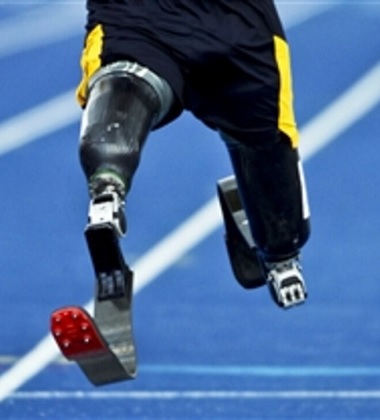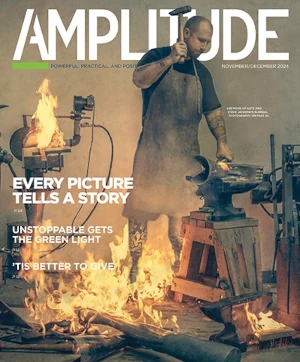Shortly after losing his left leg below the knee in 2016, Marc Dunshee went looking for a job at a prosthetist’s office.
“The whole reason was: What if I lost my insurance?” he explains. “I needed to be able to make my own leg. That was the only reason I went to work there as an employee—just so I can see what tools I need, how to cast my own limb, what to do to modify my leg before I go to Home Depot and buy all the stuff.”

Dunshee’s own prosthetist didn’t have any openings, but another clinic nearby took him on as an assistant technician. That’s where he met Kyle Trivisonno, the practice’s board certified prosthetic technician. And Trivisonno is the guy who who put Dunshee into a hemp prosthesis.
“Kyle and I became friends,” explains Dunshee. “He was back there by himself, and he was just swamped all the time. So he was training me to do stuff like pour up plaster molds and whatever else. And one day he asked me, out of the blue, what I thought about him making me a hemp socket.”
Dunshee didn’t know what to think. “I told him I’d never even considered that,’” he recalls. “I told him it sounded interesting.”
Four years later, things have gotten very interesting for the hemp prosthesis. Trivisonno’s startup, now known as Human Plant Solutions, won an incubator grant in 2018 and has gone on to attract university research funding and industry R&D partnerships. And Dunshee is the hemp socket’s living, breathing proof of concept, having logged thousands of miles as a long-distance runner in the original prototype Trivisonno built for him.
“I’ve gone hard on that socket,” says Dunshee. “It feels exactly like a carbon socket to me. I can’t feel a difference.”
The prototype’s shell consists of hemp fabric that Dunshee describes as “canvas-like material . . . . a little thicker than four-ply of carbon fiber.” The brim and bottom are reinforced with extra layers. “I haven’t had any chipping or shattering like I’ve had with carbon sockets,” Dunshee says. “I haven’t ever had to sand down the trim line.”
According to Trivisonno, hemp is 10 times stronger than carbon when properly laminated. It’s also far more supple and therefore resistant to cracking, and the natural fiber is lighter and less corrosive than carbon and fiberglass.
“Hemp fiber has a natural flex with a strong energy return,” adds Sam Spallitta, Trivisonno’s partner in Human Plant Solutions and the company’s CEO. “I’m not going to say it’s better than carbon, but it’s got amazing benefits from a patient standpoint. Marc’s been wearing the prototype for going on four years. He’s competed in Ironman races in the device. He just recently ran in the (virtual) Boston Marathon. It has outlived his carbon devices.”
Dunshee’s migration to the hemp socket coincided with his midlife rejuvenation as an athlete. He hurt his leg 15 years ago in a dirt-bike accident and spent the next decade managing pain and enduring reconstructive surgeries. When he finally elected to amputate in 2016, says Dunshee, “I just felt like a better person.”
Freed from pain and pain-killers, he was able to get active again and shed the 35 pounds he’d gained while he was debilitated. He started doing pushups, then bicycling, then jogging. “It was run a block, walk a block at first,” he says. When his daughter participated in a Girls on the Run 5K race, Dunshee ran it with her and surprised himself by not only finishing, but posting a pretty good time.
“I’m 43 years old,” he says. “And I look around and most 40-year-old men I see, they don’t run anywhere. So when I race, I actually make the podium sometimes. That’s the shocking part to me. I’m actually hanging with [able-bodied] people in my age group.”
In the last two years, the hemp socket has carried Dunshee through two marathons and a 70.3 Ironman triathlon (1.2-mile swim, 56-mile bike ride, 13.1-mile run). He’s slated to compete in a 50k ultradistance race in April (COVID permitting). It’s even possible Dunshee will turn pro as Human Plant Solutions’ full-time sponsored athlete and hemp-leg ambassador. (Here’s a short video of Dunshee running on the hemp prosthesis. You can follow him on Instagram at @asher910.)
Asked to describe the type of amputee who would benefit most from a hemp socket, he says: “You’re someone who believes in sustainability. We all have an impact in what we leave behind, and personally I would rather leave behind some hemp than all that carbon fiber. They give you a new one of these things every year, you know? And I’ve got the same hemp leg from four years ago.”
“Hemp is cheaper, less caustic, and easier to finish,” Spallitta adds. “It’s a better material for a prosthetic from a sustainability standpoint and a manufacturing standpoint.”
After relocating from North Carolina to Wichita, Kansas, in late 2020, Human Plant Solutions is gearing up to start fabrication in the spring of 2021. If you happen to try a hemp socket, email us at editor@livingwithamplitude.com and let us know what you think.





